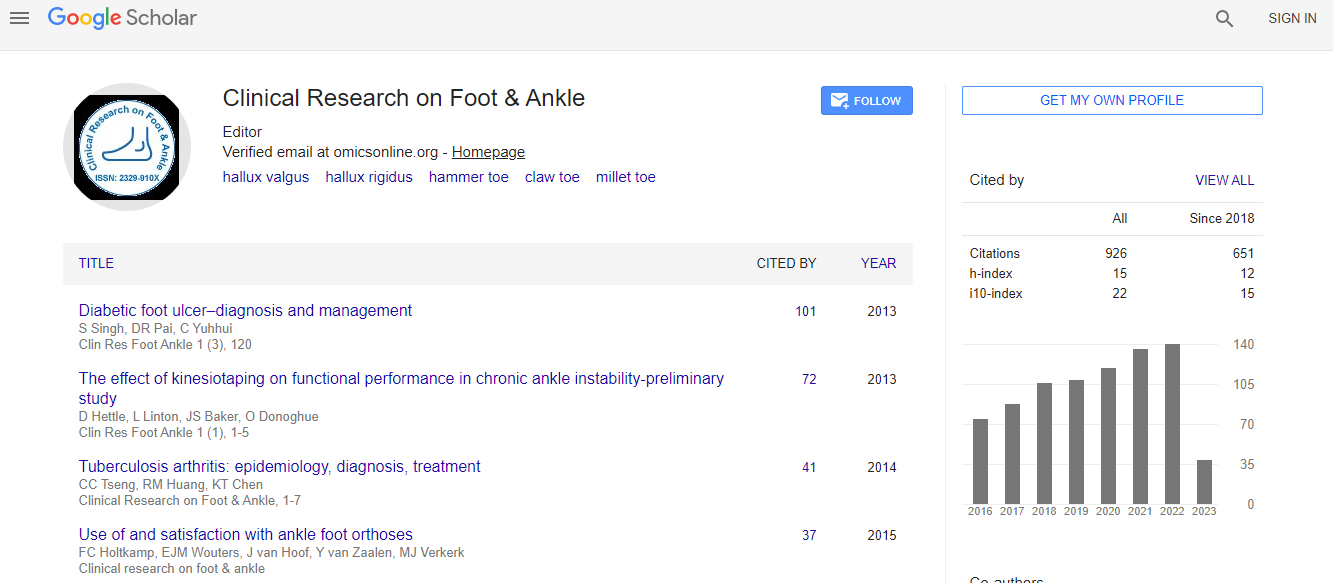Research Article
Alterations in Evertor/Invertor Muscle Activation and Cop Trajectory during a Forward Lunge in Participants with Functional Ankle Instability
| Ty Hopkins J1*Mark Coglianese2Shane Reese3Matthew K Seeley1 | ||
| 1Human Performance Research Center, Brigham Young University, USA | ||
| 2Department of Health, Recreation & Human Performance, Brigham Young University, USA | ||
| 3Department of Statistics, Brigham Young University, USA | ||
| Corresponding Author : | Ty Hopkins J Professor, Human Performance Research Center Brigham Young University, Provo, UT 84602, USA Tel: (801) 422-1573 E-mail: tyhopkins@byu.edu |
|
| Received September 22, 2013; Accepted November 27, 2013; Published December 03, 2013 | ||
| Citation: Ty Hopkins J, Coglianese M, Reese S, Seeley MK (2013) Alterations in Evertor/Invertor Muscle Activation and Cop Trajectory during a Forward Lunge in Participants with Functional Ankle Instability. Clin Res Foot Ankle 1:122. doi:10.4172/2329-910X.1000122 | ||
| Copyright: © 2013 Ty Hopkins J, et al. This is an open-access article distributed under the terms of the Creative Commons Attribution License, which permits unrestricted use, distribution, and reproduction in any medium, provided the original author and source are credited. | ||
Related article at Pubmed Pubmed  Scholar Google Scholar Google |
||
Abstract
Objectives: Participants with ankle instability demonstrate more foot inversion during the stance phase of gait than able-bodied subjects. Invertor excitation, in combination with evertor inhibition may contribute to this potentially injurious position. This alteration may be more pronounced when additional loads are placed on the foot during functional movements. The purpose of this experiment was to examine evertor/invertor muscle activation and foot center of pressure (COP) trajectory during foot loading in participants with functional ankle instability (FI).
Methods: Twelve subjects were identified with FI and matched to healthy controls. Tibialis anterior (TA) and peroneus longus (PL) electromyography (EMG), as well as COP, were recorded during the entire stance portion of a forward lunge. Functional analyses were used to detect differences between FI and control subjects with respect to normalized EMG amplitude and COP trajectory during the stance portion of the forward lunge.
Results: The functional analysis revealed no differences between groups during the stance phase of the lunge for PL EMG or COP. The FI group did exhibit significantly less TA activation at the beginning and end of stance. However, TA activation increased in the FI group relative to controls during the loading portion of stance.
Conclusion: While COP did not deviate during a loading task, the observed motor strategies could contribute to movement/stabilization alterations in a FI population. Treatment of FI should consider interventions focused on forcing normal activation of the invertors/evertors.

 Spanish
Spanish  Chinese
Chinese  Russian
Russian  German
German  French
French  Japanese
Japanese  Portuguese
Portuguese  Hindi
Hindi 
